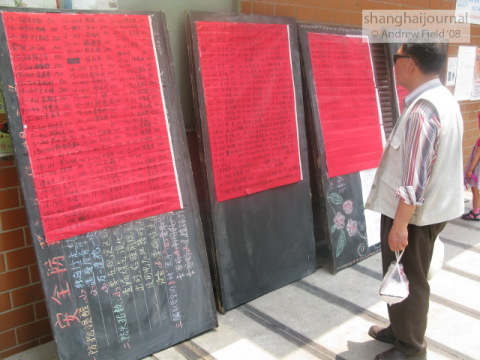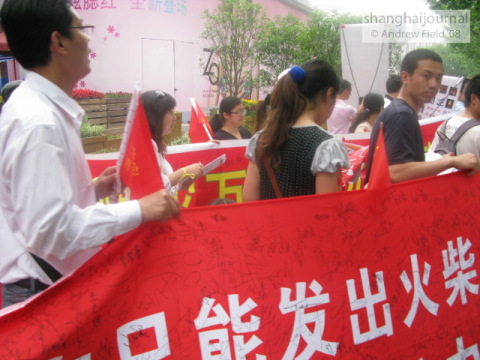
Since the earthquake blasted Wenchuan County in Sichuan last Tuesday, the news media here has been filled with terrifying and heroic images of quake damage, survivors, and rescuers. Indeed, the alacrity with which the government, military, and police have responded to this disaster is truly impressive, especially when compared to what a close relation of mine referred to as the “sluggish efforts” of the US government following the Katrina disaster in ’05. Moreover, the entire country seems to have been mobilized to respond to this crisis. Here in Shanghai, every company, school, housing complex, and any other institution has been busy collecting donations. Above is a photo taken yesterday in our housing complex, listing the names of people who gave money as well as the amount they gave. The donations have thus become a highly public form of status recognition. The same thing occurred in Sarah’s kindy, where the kids were bringing in coins last week to give their teachers. Whether and how the money will end up in the right hands is another question and beyond the capabilities of this reporter to determine.
Last night my mother-in-law was watching a special program aired on CCTV about the heroic efforts of military and police to rescue quake victims in Sichuan. Two well-known TV personalities hosted the event, which featured several soldiers and police officers involved in rescue missions. One man, a Qiang nationality, had lost most of his family in the quake, but still soldiered on helping to save others. Indeed this was a moving segment. They then brought onstage three children whose parents were unaccounted for. Several celebrities mounted the stage and cuddled the kids as they cried their hearts out. As the camera panned over the audience, consisting of CCP cadres and army officers, mostly middle-aged, nary a dry eye could be found. Then the celebrities fell into a procession where they each put a large bagful of money into a slot in a box. On the bag was the name of the celebrity and the amount donated—figures reaching up to one million yuan per person.
The female announcer asked one of the tearful orphan girls if she would continue studying for her gaokao (national college entrance exam). Choking back her tears, she vowed she would do so, in honor of her parents. Everyone clapped and cheered. The announcer then pledged to the audience that the “aunts and uncles” in the auditorium would bear the burden of the onstage orphans’ college education if they passed their exams. Again, more applause.
Again, this author wonders what will happen to all this money being donated to the cause, and where it will end up. Also, will these folks make good on their TV pledge to pay for the educations of these children? What about other children who were orphaned in the disaster? Will they also be taken care of?
As Naomi Klein wrote recently in an article in The Nation, major natural disasters challenge the governments of authoritarian regimes by calling into question their omnipotence and their ability to deliver their people from calamity. China has responded with great enthusiasm, on government, institutional, and popular levels. Yet when the dust settles, the question of building materials and local government corruption will no doubt be raised, as it already has been by some of the victims. A few years ago, Zhu Rongji coined the phrase “tofu engineering” (doufu jia gongcheng). Even journalists and TV stations have noted how quickly the schools fell compared to other buildings, though it seems the central government has made an effort to suppress these sorts of reports here in the Mainland. And for good reason. Let’s mobilize our country to take care of the survivors of first, then assess the causes for the deaths, seems to be the going philosophy, and one can hardly find fault with that.

Above: Young people in Shanghai on Huaihai Road carrying a banner and seeking pledges for the quake victims, taken on Sunday May 18. Only a segment of the banner appears in this photo. The entire sign reads 也许你只能发出火柴的光芒,但也能温暖灾难的孩子 ("maybe you can only produce a flame from a match, but you can still warm the children victimized by the disaster").
Meanwhile, despite the rallies and pledge drives, things go on pretty much as usual here in Shanghai. Last Friday, an old mate of mine from Taiwan named Mo Jin arrived in town. Though I was exhausted from the day, having cycled all the way into town and then taken my students on a five-hour walking tour of the French Concession (see previous blog) and cycled back to Zhabei, and though I’d spent the evening getting my daughter tucked into bed (an hour to two-hour process depending on her mood), and though I was already half-asleep when he called, Mo Jin applied the old “friends come from afar” (you pengzi yuanfang lai) line and I had to get into evening clothes and into a cab and head into town to take him to the latest hot clubs. After all, when duty calls, Dr. Nightlife answers, whether rain or snow or hail or acts of God…
So I met Lao Mo at his hotel and accompanied him over to the Bund. Bypassing a big line of people at the elevators, we walked up four flights of majestic stairs, paid a whopping 150 yuan cover charge and headed into Lounge 18. This club is located on the 4th floor of Building 18, which also houses Bar Rouge where I’d hung out with John Cusack and his entourage a month ago. The reason for the stiff entrance fee was that DJ Ravin from the Buddha Bar was playing that night. This is the kind of gimmick that Shanghai loves to pull off. Well, as a nightlife researcher I like to keep an open mind and be “objective” (if such a concept really exists) about the club scene. But an hour in this club and I was ready to head elsewhere. Why? Let me tell you.
I am a stickler for club design. Design trumps just about everything. This club is not well designed. The bar is way too small. People were crowded around the bar trying to get drinks. The bar was understaffed. The bartenders were not well trained, but they were trying their best to serve the customers. It took twenty minutes just to get a bartender’s attention. The drinks were overpriced. 70 yuan for a highball. We ordered martinis. As seems to be typical of the Shanghai club scene now, martinis are hard to find. Instead we were given highballs. Sweet and sickly, with a lychee instead of an olive. Low quality vodka. Low alcohol content. 70 RMB. Would you put up with that?
The club must have been an office or bank back in the ‘30s. As the placed filled up, the flow became more and more chaotic. People were bumping and jostling each other. It was hard to find a spot away from traffic. Most of the men in the club were big beefy western expats, not the slenderer, slicker Chinese clubbers who tend to be more graceful and certainly more used to navigating through tight crowds. The rubbing and jostling created a lot of negative friction (often leading to confrontations and nasty experiences). To be sure, as Mo Jin remarked, lots of ladies were out that night in their hottest outfits. But it’s hard to enjoy a club scene so poorly choreographed, no matter who shows up.
Upon my counsel we left the place and cabbed it over to Yuyao Road to hit Muse, the subject of some of my previous blogs on Shanghai nightlife. Mo Jin hadn’t been there and I wanted to show him how a well-designed Shanghai club operated. As I wrote in my recently published article on clubbing in Shanghai, this club was designed by a locally based design team, Neri and Hu, who also designed 3 on the Bund and other contemporary Shanghai icons. They put a tremendous amount of thought and effort into designing the club. The results are noticeable.
On the main floor, the spacious bar covers all four sides (Lounge 18’s bar is wedged into a corner and only has a small L for customers) and the well-trained and efficient bartenders make sure it takes only a couple minutes at most to get you your drinks. Also, since most guests on this floor occupy the tables and lounge spaces, they’ve already got their drinks in the form of high-status bottles, so the competition for drinks at the bar is minimized. The tables and lounge spaces are spaced out enough so that the flow is smooth and continuous.
The place has been well-designed for circulation. Heading upstairs, you have the hip-hop club with live music and a lot of mixing and mingling. Again, despite an occasional bottleneck, one never gets a claustrophobic feeling or feels pressured to elbow people out of the way. Please feel free to leave a comment if you feel different.
Perhaps everyone was jaded from the inundation of news about the quake and just wanted to party. But it felt strange to be in such a party atmosphere after the week’s heavy news. It struck me that these clubs could have offered to donate some of the evening’s precedings to the relief efforts, but if that was the case, I sure didn’t see any signs of it. Maybe there are too many issues with taxation and off-the-books accounting for clubs to risk publicizing their accounts.
At 2 am my carriage turned into a pumpkin and my horses back into mice. I had to scamper out into the night and head home to family. In order to clear my head, I took a walk down the dark, largely empty streets of this Shanghai neighborhood, passing a few restaurants where late-night folk were cramming down bowls of noodles. Other than a few convenies and the occasional sperm bank, there weren’t many signs of life. While a select crowd partied on, most of Shanghai slept peacefully, charging their batteries for the day ahead.